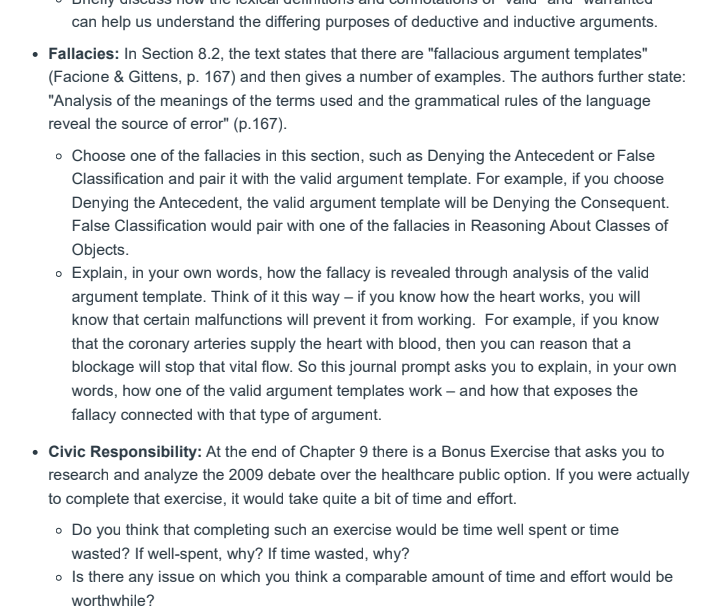
Introduction
Remember – your actual journal entry should be somewhat brief; most of your time should be spent thinking about the questions asked and the issues raised. Your thoughts should then be distilled into a mini-argument that will respond affirmatively to the four tests for evaluating arguments: truthfulness of premises, logical strength, relevance, and non-circularity.
Instructions
For this journal assignment, briefly answer each of the following prompts:
- Inference: The differing meanings of “valid inference” and “warranted inference” are closely related to the differing purposes of deductive and inductive arguments – the purpose of deductive being to prove; the purpose of inductive to make the conclusion most probable.
- Look up the words “valid” and “warranted.” Each of these words, you will find, has what is known as a lexical definition – that is just the dictionary definition of the word. Words also have a certain connotations – meanings that go beyond their lexical definitions; associated ideas and concepts – think of terms such a “fur baby” as the name for a pet.
- Briefly discuss how the lexical definitions and connotations of “valid” and “warranted” can help us understand the differing purposes of deductive and inductive arguments.
- Fallacies: In Section 8.2, the text states that there are “fallacious argument templates” (Facione & Gittens, p. 167) and then gives a number of examples. The authors further state: “Analysis of the meanings of the terms used and the grammatical rules of the language reveal the source of error” (p.167).
- Choose one of the fallacies in this section, such as Denying the Antecedent or False Classification and pair it with the valid argument template. For example, if you choose Denying the Antecedent, the valid argument template will be Denying the Consequent. False Classification would pair with one of the fallacies in Reasoning About Classes of Objects.
- Explain, in your own words, how the fallacy is revealed through analysis of the valid argument template. Think of it this way – if you know how the heart works, you will know that certain malfunctions will prevent it from working. For example, if you know that the coronary arteries supply the heart with blood, then you can reason that a blockage will stop that vital flow. So this journal prompt asks you to explain, in your own words, how one of the valid argument templates work – and how that exposes the fallacy connected with that type of argument.
- Civic Responsibility: At the end of Chapter 9 there is a Bonus Exercise that asks you to research and analyze the 2009 debate over the healthcare public option. If you were actually to complete that exercise, it would take quite a bit of time and effort.
- Do you think that completing such an exercise would be time well spent or time wasted? If well-spent, why? If time wasted, why?
- Is there any issue on which you think a comparable amount of time and effort would be worthwhile?
- As a critical thinker, do you believe that citizens have an obligation to be informed on topics of current interest? If yes, why, if no, why not?
ANSWER:
The words warrant ad valid are used in deductive and inductive arguments, respectively. Merriam Webster dictionary provides numerous definitions for the term warrant. It defines it as a guarantee of the truth or security of something. It is an assurance of certainty or a guarantee that something is as it is said to be. The same dictionary defines the word ‘valid’ as having legal force or efficacy. It is also used to mean logically correct, effective, and conforming to the standards of reasonable biological classification. It is the connotation for logical or sensible reasoning.
In deductive reasoning, the truth is derived from given premises with a warrant (certainty) (Facione & Gittens, 2016). Granted that the premises are all true, then it is argued that the conclusions are true. For instance, one can say:
All men are mortal.
Quincy is mortal.
In this example, the conclusion is that since all men are mortal, then Quincy, who is also a man, is mortal. In inductive reasoning, we infer causes from assumed effects (Facione & Gittens, 2016). Given that it entails inferential data, there is no guarantee that the conclusions are true… click the purchase button below to access full answer.
